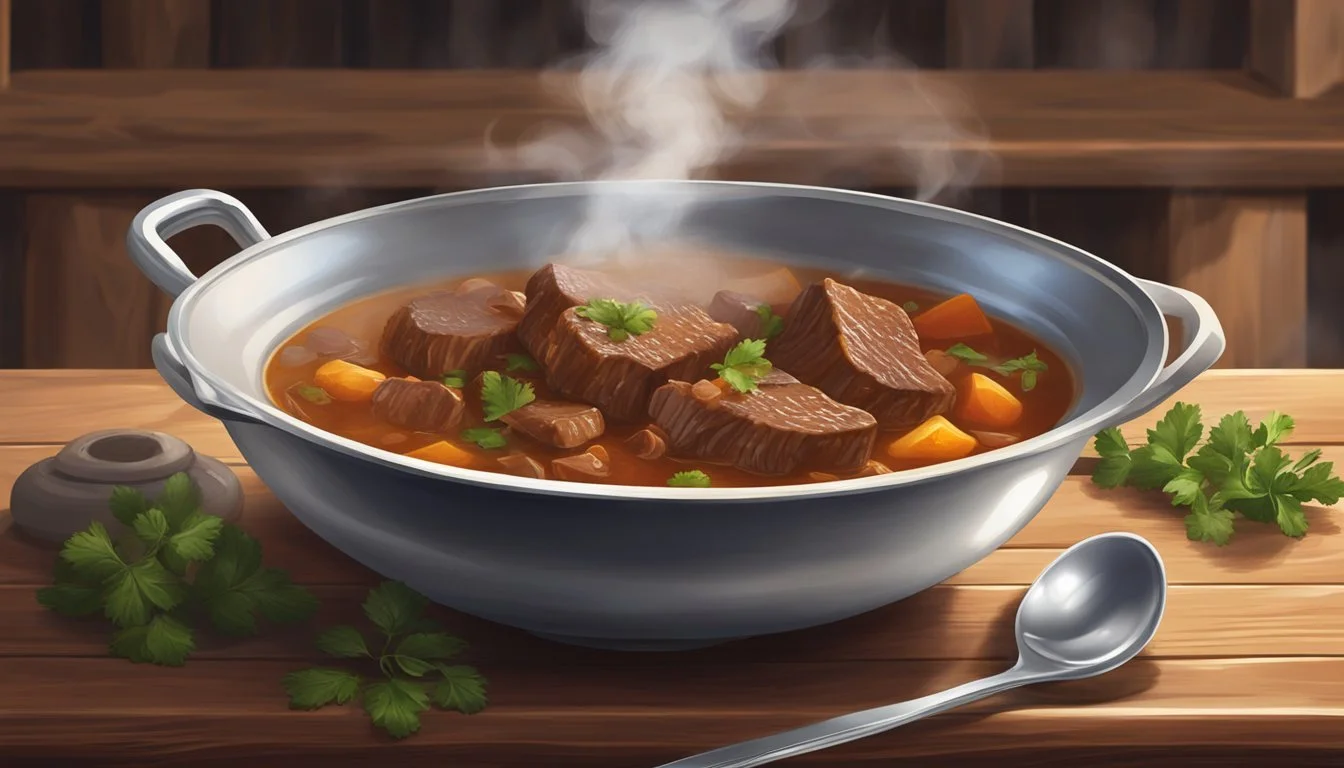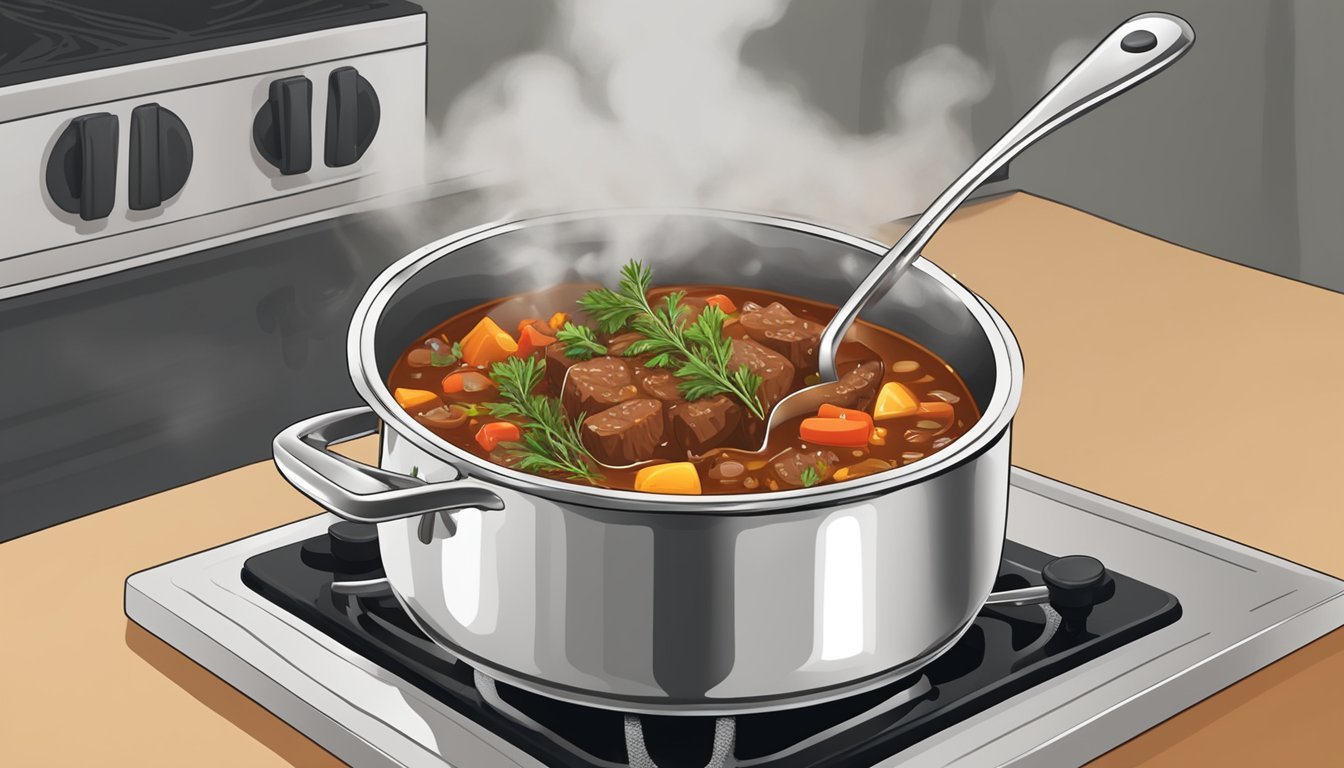How to Reheat Beef Goulash
Simple and Effective Methods
Goulash, a hearty dish with roots in Hungarian and American culinary traditions, demands a careful approach when it comes to reheating. To reheat beef goulash while retaining its rich flavors and tender texture, the oven method is highly recommended: Preheat the oven to 325°F (163°C), place the goulash in an oven-safe dish, cover it with aluminum foil or a lid, and bake for 20-25 minutes.
Perhaps you're short on time and prefer quicker options. Microwave reheating can be effective if done right: transfer the goulash to a microwave-safe dish, cover, and heat in 2-minute increments, stirring in between. This prevents uneven heating and ensures the dish remains flavorful while being warmed up thoroughly.
Understanding Goulash
Goulash is a traditional dish with rich history and diverse variations. This hearty meal combines beef, vegetables, and aromatic spices, providing both robust flavor and nutritional value.
Origins and Variations
Goulash originated in Hungary, with its roots tracing back to the stews prepared by Hungarian shepherds. Traditionally, Hungarian goulash features beef, onions, and a generous amount of paprika. Unlike the European variant, American goulash often includes ground beef and macaroni, making it more of a pasta-based dish. While both versions share similarities, Hungarian goulash is typically soupier and more focused on its spicy broth and tender chunks of beef.
Classic Ingredients
The essential ingredients of goulash are beef, onions, and paprika. The choice of beef is crucial for achieving the desired tenderness, often using cuts like chuck or shank. Onions are the base, providing a sweet undertone. Paprika delivers the signature flavor and color. Vegetables like carrots, tomatoes, and peppers are commonly added. Sometimes, potatoes or parsnips can be found in the mix. The broth, usually beef or a mix of beef and vegetable broths, unites these ingredients into a savory, cohesive dish.
Nutrition Information
Beef goulash is a nutrient-dense dish. A typical serving offers a balance of proteins, carbohydrates, and fats. Beef provides high-quality protein and essential minerals like iron and zinc. Vegetables contribute vitamins such as A and C, and fiber. The presence of ingredients like paprika and tomatoes adds antioxidants, particularly lycopene. While goulash can be calorically rich, its components are largely beneficial, making it a wholesome yet indulgent dish.
Preparing the Goulash
Goulash is a hearty dish with rich flavors from beef, vegetables, and spices. Whether sticking to the classic recipe or exploring variations, each approach reveals unique aspects of this comfort food.
The Base Recipe
Start by heating olive oil in a large Dutch oven or pot over medium heat. Add onions and garlic, sautéing until they soften. Next, season the ground beef and brown it thoroughly on all sides. This step builds depth in flavor.
Once browned, add tomato sauce and beef broth. Bring to a simmer and stir occasionally. Incorporate bell peppers and pasta, letting the mixture cook until the pasta is tender. This combination of ingredients develops a robust base for the goulash. Balance flavors with salt, pepper, and other spices as desired.
Goulash Variations
Exploring variations introduces different textures and flavors. Substitute ground beef with stew meat for a richer taste. Another option includes adding cheese either melted on top or stirred into the mix for a creamy texture.
For a twist, some recipes incorporate paprika or chili flakes for a spicy kick. Vegetarian versions use beans and omit meat, maintaining richness with vegetable broth. Adding vegetables like zucchini or corn can also enhance the dish.
Each variation adjusts cooking techniques slightly to suit the ingredient changes, ensuring the goulash remains flavorful and satisfying.
Food Safety and Storage
Properly handling and storing beef goulash is essential to maintaining its quality and ensuring food safety. Learn how to store your leftovers correctly and the best methods to freeze and thaw your goulash.
Storing Leftover Goulash
To keep leftover goulash fresh, it should be stored in an airtight container. This prevents the food from drying out and protects it from airborne contaminants. Once cooked, allow the goulash to cool to room temperature before transferring it to the refrigerator.
Refrigeration should be set at or below 40°F (4°C) to slow bacterial growth. The goulash should be consumed within 3-4 days for optimal safety and taste. When reheating, ensure that the internal temperature reaches at least 165°F (74°C) to eliminate any potential bacteria.
Label containers with the date so you can track the storage time. Avoid leaving the goulash out for more than 2 hours at room temperature, as this can lead to harmful bacterial growth.
Freezing and Thawing
For longer storage, goulash can be frozen. Use freezer-safe, airtight containers or heavy-duty freezer bags to prevent freezer burn. Ensure that there is a little space left at the top of the container to allow for expansion as the goulash freezes.
Goulash can be stored in the freezer for up to 2-3 months. For best results when thawing, place the frozen goulash in the refrigerator and allow it to defrost gradually. This helps in retaining the food's texture and flavor.
If you need to defrost it quickly, use the microwave's defrost setting or place the sealed container in cold water, changing the water every 30 minutes. Always reheat thoroughly to an internal temperature of 165°F (74°C) before consuming.
Reheating Beef Goulash
Reheating beef goulash can be done effectively using several methods, each ensuring that the dish remains flavorful and moist. Here’s a breakdown of four techniques: oven, stovetop, microwave, and slow cooker.
Oven Reheating Method
Preheat the oven to 325°F (163°C). Place the leftover goulash in an oven-safe baking dish. Cover the dish tightly with aluminum foil or a lid to trap moisture. Bake for 20-30 minutes, depending on the quantity, until the goulash is heated evenly throughout.
Stovetop Reheating Technique
Transfer the goulash to a large pot or saucepan. Set the heat to medium-low. Stir occasionally to prevent sticking and ensure even heating. Adding a small amount of water or broth can help maintain moisture and prevent drying out. Heat until the goulash is thoroughly warmed.
Microwave Reheating Tips
Place the goulash in a microwave-safe container. Microwave on medium-high heat for 2-3 minutes, pausing to stir every minute. This ensures even heating and prevents cold spots. After microwaving, let it stand for a minute to allow the heat to distribute evenly.
Using a Slow Cooker
Transfer the goulash to the slow cooker. Set it to the low setting. Allow the goulash to reheat slowly over 2-3 hours. This method is ideal for reheating larger quantities and ensuring that the flavors meld together without overcooking. Regularly stir to avoid sticking and scorching.
These methods help retain the dish's moisture and flavor, ensuring a enjoyable meal from leftovers.
Tips for the Best Reheated Goulash
When reheating beef goulash, it's essential to focus on maintaining its rich flavor and tender texture. Avoid dryness and overheating by using the right techniques and consider adding fresh toppings to enhance its taste.
Maintaining Flavor and Texture
To keep the goulash flavorful, reheat it at a moderate temperature. Oven reheating is an excellent choice. Preheat the oven to 325°F (163°C) and place the goulash in an oven-safe dish. Cover tightly with aluminum foil to trap moisture and heat evenly.
Stirring occasionally during reheating helps distribute the heat. This method prevents the edges from drying out while ensuring the center is warmed thoroughly. Alternatively, use a microwave on medium-high heat for short intervals, stirring between each to maintain an even texture.
Preventing Dryness and Overheating
Prevent the goulash from drying out by adding a small amount of liquid before reheating. A few tablespoons of water, broth, or even tomato sauce can replenish lost moisture. This step is crucial, especially if the goulash was stored in the fridge for a couple of days.
Covering the dish with a lid or foil is essential. It creates a steamy environment, which helps retain moisture and prevents the goulash from becoming gritty or tough. Always reheat slowly and avoid high temperatures that can lead to overheating and dryness.
Toppings and Add-Ons
Enhancing reheated goulash with fresh toppings can elevate its flavor profile. Consider adding a dollop of sour cream to each serving for a creamy contrast. Fresh herbs like parsley can add a burst of color and freshness.
For a richer experience, sprinkle grated cheese over the top and let it melt slightly before serving. This addition not only adds a savory depth but also enhances the overall mouthfeel of the dish. Experiment with different toppings to find the perfect complement to the hearty flavors of the goulash.
Serving and Garnishing
Proper serving and garnishing of beef goulash can elevate the dish's presentation and enhance its flavors. Key considerations involve selecting suitable accompaniments and presenting the dish attractively.
Accompaniments
Beef goulash pairs well with a variety of accompaniments to complement its rich, hearty flavors. Crusty bread is a popular choice, serving to soak up the savory sauce. For a lighter option, steamed rice or buttered noodles can be excellent alternatives.
Additionally, consider adding sour cream to the side, as it introduces a pleasant creaminess. For those who enjoy a touch of freshness, a simple cucumber salad or lightly seasoned mixed greens can balance the meal. Including roasted or mashed potatoes can also provide a satisfying and filling complement to the goulash.
Presentation
Garnishing beef goulash thoughtfully can significantly enhance its visual appeal. Fresh parsley is an ideal garnish, sprinkled on top for a pop of color and an added layer of flavor. For a richer taste, consider topping the dish with a dollop of sour cream or a sprinkle of grated cheese such as Parmesan or Gouda.
Serving the goulash in an attractive ceramic or porcelain bowl, ideally warmed before use, helps maintain its temperature and adds a touch of elegance. Using contrasting dishware colors can make the dish more visually appealing. Arranging accompaniments like bread slices or salad around the main dish offers a cohesive and inviting presentation.
Conclusion
Reheating beef goulash offers a wonderful way to relive the comfort and simplicity of this traditional dish.
For the oven method, preheat to 325°F (163°C), place the goulash in an oven-safe dish, cover with aluminum foil or a lid, and heat for 20-30 minutes. This method is great for retaining moisture and flavor.
Using a skillet or pot, set the heat to medium-low, stir frequently, and add a bit of water or beef stock if needed. Heat for 5-7 minutes, then simmer for an additional 2-3 minutes. This approach ensures even heating.
Whether opting for the oven or stovetop, these methods honor the dish's tradition while maintaining its delicious taste and texture.





